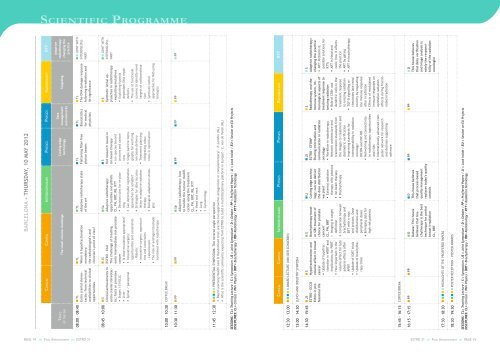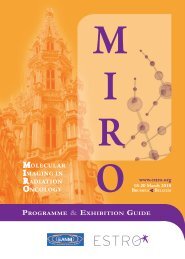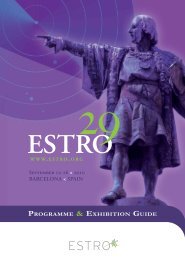9-13 May 2012 • Barcelona, Spain - Estro-events.org
9-13 May 2012 • Barcelona, Spain - Estro-events.org
9-13 May 2012 • Barcelona, Spain - Estro-events.org
You also want an ePaper? Increase the reach of your titles
YUMPU automatically turns print PDFs into web optimized ePapers that Google loves.
PHYSICS PRe-MeeTIng COuRSe <strong>•</strong> WeDneSDaY, 9 MaY <strong>2012</strong><br />
course dIrector:<br />
H. nyström (Se)<br />
Pre re-M -Meeting eeting CCourses<br />
ourses<br />
WHaT a PHYSICIST SHOuLD COnSIDeR beFORe gOIng InTO a PROTOn THeRaPY PROJeCT<br />
course aIms:<br />
In many countries in europe as well as in the rest of the world, proton therapy facilities are either in the process of<br />
being created or are already well-established. In fact, the increase in the number of new facilities has been more or<br />
less exponential for many years, leading to an increased demand for medical physicists capable of carrying out proton<br />
therapy projects.<br />
There are many obvious advantages when using proton therapy compared to conventional photon based radiotherapy,<br />
since a significantly larger fraction of the absorbed dose is actually delivered to the target volumes and an overall superior<br />
dose distribution is achieved.<br />
However, substantial differences exist in terms of technology, treatment planning, dosimetry, Qa etc. What is a reasonable<br />
staffing level? What is a reasonable “business plan”? How should acceptance testing be performed? What are<br />
the demands for clinical commissioning? What are the demands for treatment planning? What are the demands for Qa?<br />
This course aims at answering a few of the above-mentioned questions and at giving an overview of the particular aspects<br />
of radiotherapy that are specific to proton therapy. In particular those involved in the start up phase of a proton<br />
therapy project or those that are considering entering into such a project would benefit from participation.<br />
Who should attend?<br />
The participant in the course is expected to be a medical physicist experienced in conventional radiotherapy but curious<br />
about proton therapy.<br />
content:<br />
<strong>•</strong> Introduction to the physics and basic dosimetry of protons,<br />
<strong>•</strong> acceptance testing and clinical commissioning of scanned and scattered proton beams,<br />
<strong>•</strong> Treatment planning for protons, including margin concepts,<br />
<strong>•</strong> CT scanning and the handling of image artefacts,<br />
<strong>•</strong> Obtaining an efficient patient flow in a multi gantry PT facility,<br />
<strong>•</strong> Qa and verification planning.<br />
ESTRO<br />
31<br />
<strong>2012</strong><br />
PHYSICS PRe-MeeTIng COuRSe <strong>•</strong> WeDneSDaY, 9 MaY <strong>2012</strong><br />
JoIntly <strong>org</strong>anIsed by gec-estro brachyphysIcs group and estro physIcs commIttee<br />
ReCenT aDVanCeS In bRaCHYTHeRaPY PHYSICS<br />
course dIrectors:<br />
J. LM Venselaar (nL) and D. baltas (De)<br />
course aIms:<br />
<strong>•</strong> To demonstrate the most recent developments in brachytherapy physics: a discussion on recent and future societal<br />
reports and recommendations,<br />
<strong>•</strong> To discuss the developments in source calibration, quality assurance, and new equipment,<br />
<strong>•</strong> To discuss the steps towards modern 3D conformal image based brachytherapy,<br />
<strong>•</strong> To discuss new and forthcoming advanced treatment planning: model based dose calculation algorithms and inverse<br />
planning and optimisation methodologies in intensity modulated brachytherapy,<br />
<strong>•</strong> To discuss the similarities and differences between modern 3D conformal eRT and bRT and its consequences for the<br />
concepts of margins.<br />
Who should attend?<br />
The course is aimed primarily at medical physicists and medical physicists in training, and at radiation technologists<br />
willing to update themselves on the latest developments in brachytherapy physics. a basic knowledge of brachytherapy<br />
physics is required.<br />
content:<br />
<strong>•</strong> Status of present day brachytherapy physics: weak and strong points, challenges and possibilities, and recent technological<br />
developments,<br />
<strong>•</strong> Calibration of sources, RaKR/Sk, and/or dose-to-water concept (iMeRa project); dosimetry chain from PSDL to enduser,<br />
<strong>•</strong> new approaches in brachytherapy dose calculation: model based dose calculation algorithms (MC, grid based boltzmann<br />
solvers, primary/scatter separation),<br />
<strong>•</strong> Inverse planning and optimisation methodologies in intensity modulated brachytherapy,<br />
<strong>•</strong> Image guided brachytherapy: use of CT and MRI, uS (and PeT) in bT, choice of settings, sequences, fusion, functional<br />
imaging,<br />
<strong>•</strong> Specific Qa requirements for modern imaging procedures in RT and bT,<br />
<strong>•</strong> uncertainties associated with the physical aspects: calibration and dose calculation,<br />
<strong>•</strong> uncertainties associated with the clinical steps: accuracy in imaging, reconstruction, delivery, implications of inter/<br />
intrafraction movement,<br />
<strong>•</strong> Similarities and differences in modern 3D conformal eRT and bRT and its consequences for margin concepts,<br />
<strong>•</strong> In-vivo dosimetry: techniques and possible applications.<br />
Page 8 /// FInal announcement /// eSTRO 31 eSTRO 31 /// FInal announcement /// Page 9









